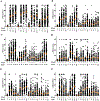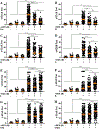Bioflavonoids cause DNA double-strand breaks and chromosomal translocations through topoisomerase II-dependent and -independent mechanisms
- PMID: 32087851
- PMCID: PMC7079294
- DOI: 10.1016/j.mrgentox.2020.503144
Bioflavonoids cause DNA double-strand breaks and chromosomal translocations through topoisomerase II-dependent and -independent mechanisms
Abstract
Bioflavonoids have a similar chemical structure to etoposide, the well-characterized topoisomerase II (Top2) poison, and evidence shows that they also induce DNA double-strand breaks (DSBs) and promote genome rearrangements. The purpose of this study was to determine the kinetics of bioflavonoid-induced DSB appearance and repair, and their dependence on Top2. Cells were exposed to bioflavonoids individually or in combination in the presence or absence of the Top2 catalytic inhibitor dexrazoxane. The kinetics of appearance and repair of γH2AX foci were measured. In addition, the frequency of resultant MLL-AF9 breakpoint cluster region translocations was determined. Bioflavonoids readily induced the appearance of γH2AX foci, but bioflavonoid combinations did not act additively or synergistically to promote DSBs. Myricetin-induced DSBs were mostly reduced by dexrazoxane, while genistein and quercetin-induced DSBs were only partially, but significantly, reduced. By contrast, luteolin and kaempferol-induced DSBs increased with dexrazoxane pre-treatment. Sensitivity to Top2 inhibition correlated with a significant reduction of bioflavonoid-induced MLL-AF9 translocations. These data demonstrate that myricetin, genistein, and quercetin act most similar to etoposide although with varying Top2-dependence. By contrast, luteolin and kaempferol have distinct kinetics that are mostly Top2-independent. These findings have implications for understanding the mechanisms of bioflavonoid activity and the potential of individual bioflavonoids to promote chromosomal translocations. Further, they provide direct evidence that specific Top2 inhibitors or targeted drugs could be developed that possess less leukemic potential or suppress chromosomal translocations associated with therapy-related and infant leukemias.
Keywords: DNA damage; Double-strand break; Environmental mutagenesis; Etoposide; Genome instability; Topoisomerase II.
Copyright © 2020 Elsevier B.V. All rights reserved.
Conflict of interest statement
Declaration of Competing Interest The authors declare no conflicts of interest.
Figures



Similar articles
-
Bioflavonoids promote stable translocations between MLL-AF9 breakpoint cluster regions independent of normal chromosomal context: Model system to screen environmental risks.Environ Mol Mutagen. 2019 Mar;60(2):154-167. doi: 10.1002/em.22245. Epub 2018 Nov 2. Environ Mol Mutagen. 2019. PMID: 30387535 Free PMC article.
-
TDP2 suppresses chromosomal translocations induced by DNA topoisomerase II during gene transcription.Nat Commun. 2017 Aug 10;8(1):233. doi: 10.1038/s41467-017-00307-y. Nat Commun. 2017. PMID: 28794467 Free PMC article.
-
Topoisomerase II-Induced Chromosome Breakage and Translocation Is Determined by Chromosome Architecture and Transcriptional Activity.Mol Cell. 2019 Jul 25;75(2):252-266.e8. doi: 10.1016/j.molcel.2019.04.030. Epub 2019 Jun 12. Mol Cell. 2019. PMID: 31202577 Free PMC article.
-
Etoposide and illegitimate DNA double-strand break repair in the generation of MLL translocations: new insights and new questions.DNA Repair (Amst). 2006 Sep 8;5(9-10):1109-18. doi: 10.1016/j.dnarep.2006.05.018. Epub 2006 Jun 30. DNA Repair (Amst). 2006. PMID: 16809075 Review.
-
Mechanisms to Repair Stalled Topoisomerase II-DNA Covalent Complexes.Mol Pharmacol. 2022 Jan;101(1):24-32. doi: 10.1124/molpharm.121.000374. Epub 2021 Oct 23. Mol Pharmacol. 2022. PMID: 34689119 Review.
Cited by
-
Analysis of m6A RNA Methylation-Related Genes in Liver Hepatocellular Carcinoma and Their Correlation with Survival.Int J Mol Sci. 2021 Feb 2;22(3):1474. doi: 10.3390/ijms22031474. Int J Mol Sci. 2021. PMID: 33540684 Free PMC article.
-
The multiple biological activities of hyperoside: from molecular mechanisms to therapeutic perspectives in neoplastic and non-neoplastic diseases.Front Pharmacol. 2025 Mar 3;16:1538601. doi: 10.3389/fphar.2025.1538601. eCollection 2025. Front Pharmacol. 2025. PMID: 40098612 Free PMC article. Review.
-
Innovative composite systems for enhancing plant polyphenol stability and bioavailability.Food Sci Biotechnol. 2025 Jan 6;34(9):1819-1834. doi: 10.1007/s10068-024-01753-3. eCollection 2025 May. Food Sci Biotechnol. 2025. PMID: 40196341 Review.
-
Application of Luteolin in Neoplasms and Nonneoplastic Diseases.Int J Mol Sci. 2023 Nov 6;24(21):15995. doi: 10.3390/ijms242115995. Int J Mol Sci. 2023. PMID: 37958980 Free PMC article. Review.
-
Possible Side Effects of Polyphenols and Their Interactions with Medicines.Molecules. 2023 Mar 10;28(6):2536. doi: 10.3390/molecules28062536. Molecules. 2023. PMID: 36985507 Free PMC article. Review.
References
-
- Broeker PLS, Super HG, Thirman MJ, Pomykala H, Yonebayashi Y, Tanabe S, Zeleznik-Le N, Rowley JD, Distribution of 11q23 breakpoints within the MLL breakpoint cluster region in de novo acute leukemia and in treatment-related acute myeloid leukemia: Correlation with scaffold attachment regions and topoisomerase II consensus binding sites, Blood. 87 (1996) 1912–1922. - PubMed
-
- Gu Y, Alder H, Nakamura T, Schichman SA, Prasad R, Canaani O, Saito H, Croce CM, Canaani E, Sequence analysis of the breakpoint cluster region in the ALL-1 gene involved in acute leukemia., Cancer Res. 54 (1994) 2327–30. http://www.ncbi.nlm.nih.gov/pubmed/8162575. - PubMed
Publication types
MeSH terms
Substances
Grants and funding
LinkOut - more resources
Full Text Sources
Miscellaneous

